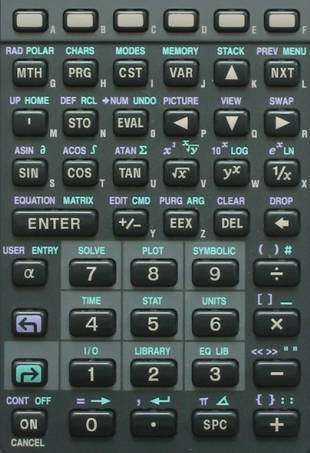
[ Main page ]
HP 48GX (US, 1993)
Driver name: hp48gx
The HP 48GX is the successor of the HP 48SX calculator by Hewlett Packard.
The HP 48GX improves on the HP 48SX model in several ways:
As the HP 48GX improves on the HP 48SX, we only document here changes with respect to the HP 48SX. Please read the HP48 SX driver documentation first.

The keyboard has the same overall layout as that of the HP 48SX. Differences include:
The screen is the same as for the HP 48SX: 131x64 pixels at 64 Hz with 2 colors (gray-scale emulated through rapid screen switching), topped with the six annunciators. It has slightly better contrast though.
The HP 48GX now has both Kermit and XModem built-in protocols. XModem is faster but has less features (in particular, file names are not sent as part of the protocol). Note also that the I/O menu is now accessible by pressing the right shift key and then 1. MESS directly emulates the serial port with a minimal built-in client for both Kermit and XModem.
Recall that downloaded files appear in the VAR menu (mapped to the [J] key) and that libraries must be attached to some port before usage. This is done as follows: push the library data on the stack, enter a port number (generally 0 which denotes the internal RAM, 1 and 2 denoting RAM extension cards in slot 1 and 2), press STO ([N] key), turn off the calculator (press right shift and the [ON] key), and back on ([ON] key). The program should be available under LIBRARY menu (right shift and [2] key).
The HP 48GX ROM has been through a set of revisions, from K (oldest) to R (most recent). The HP 48GX driver supports ROM revisions K, L, M, P, and R. Revisions N, O, and Q are either missing or were never released. By default, revision R (most recent) is used. This can be changed using the -bios command-line option, followed by a revision letter: k, l, m, p, or r.
As the HP 48SX, the HP 48GX has two extension slots that can accept one RAM or ROM card each. However, these slots have slightly different functionality:
To run the emulator with an extension card, use either the -port1 file (for slot 1) or -port2 file (for slot 2) command-line option, or both. Any modification to the memory card is automatically saved to the given file when the emulator quits. When passing the name of an non-existing file, a new memory card with 128 KB capacity is created if in slot 1, and 4 MB if in slot 2.
Because the internal RAM is 128 KB and only cards in slot 1 can be merged (using the MERGE1 command available in the secondary LIBRARY menu, which can be accessed with left shift and [2]) the user memory can be extended up to 256 KB. The same care must be taken with merged memory on the HP 48GX as on the HP 48SX: do not remove or change a merged memory card, even when the calculator is turned off. Un-merge it before with the FREE1 command.
Memory cards in slot 1 appear in library port 1. Memory cards in slot 2 with 128 KB or less appear in library port 2. Memory cards in slot 2 with more than 128 KB appear as a collection of 128 KB library ports (2 up to 33 for 4 MB cards). Note, however, that due to an operating system bug, library port 33 seems to be unusable.
This MESS driver was written by Antoine Miné.
Return to the HP 48 MESS driver page.